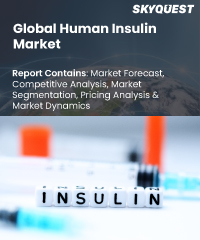
Report ID: SQMIG35I2266

Report ID:
SQMIG35I2266 |
Region:
Global |
Published Date: April, 2024
Pages:
219
|
Tables:
89 |
Figures:
76
Human Insulin Market size was valued at USD 19.37 Billion in 2023 and is poised to grow from USD 19.7 Billion in 2024 to USD 22.55 Billion by 2032, growing at a CAGR of 1.7% during the forecast period (2025-2032).
Human insulin, a lab-made replica of a natural hormone, is a cornerstone of global diabetes management. By regulating blood sugar, it offers a lifeline to millions with both type 1 and type 2 diabetes, significantly improving their quality of life. This market exists to ensure this essential treatment reaches those who need it. The human insulin market is propelled by the alarming rise in diabetes diagnoses worldwide. The International Diabetes Federation predicts a jump from 463 million adults with diabetes in 2019 to a staggering 700 million by 2045. This translates to a surge in the need for insulin, guaranteeing continued market growth.
The human insulin market thrives thanks to constant improvements in production methods, like recombinant DNA technology. These advancements have yielded highly purified and safer insulin, making it more effective and well-tolerated. This, in turn, has increased patient acceptance and market expansion. The fight against diabetes extends beyond the market. Healthcare organizations, governments, and non-profit groups are working together to raise awareness about the disease and its management. Educated patients are better equipped to manage their condition, further increasing demand for insulin. Additionally, initiatives to bring down insulin prices and improve access in developing countries are significant drivers of market growth.
Despite access initiatives, insulin's cost remains a major obstacle, especially for low-income regions. High production costs, intricate manufacturing, and limited competition inflate insulin prices, hindering affordability and market growth. Patent protections for certain insulins and complex regulations make it difficult for new players to enter the market, slowing down the development of generic and biosimilar options, which could offer patients more affordable choices and expand market reach. A shift towards analog insulin is a notable trend. Offering faster action, shorter duration, and better blood sugar control, analogs are increasingly favored by doctors and patients, boosting their market share. However, this trend can also contribute to higher overall market costs. The market is experiencing a surge in demand for insulin delivery devices like pens and pumps. These devices offer patients greater comfort and accuracy in insulin administration, improving adherence to treatment. Integration of cutting-edge technologies like connected devices and AI is further propelling the adoption of these delivery systems.
Our industry expert will work with you to provide you with customized data in a short amount of time.
REQUEST FREE CUSTOMIZATIONWant to customize this report? This report can be personalized according to your needs. Our analysts and industry experts will work directly with you to understand your requirements and provide you with customized data in a short amount of time. We offer $1000 worth of FREE customization at the time of purchase.

Report ID: SQMIG35I2266